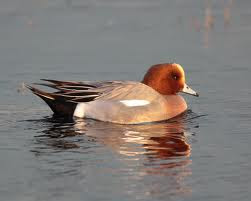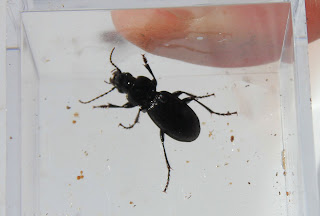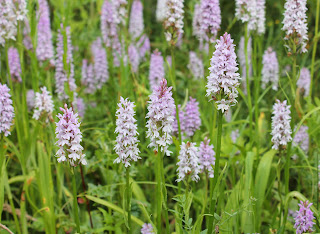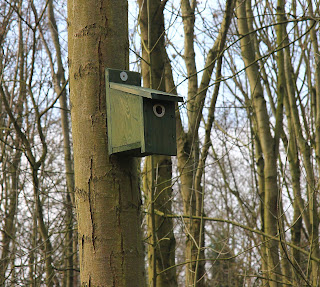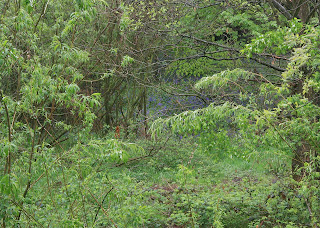
Earlier this summer, because of the ground disturbance in the vicinity of Metrolink’s St Werburgh’s Road tram stop, hundreds of arable 'weeds' appeared on the newly created embankments. The seeds of such plants can remain buried but viable for decades (perhaps even for a century or more) and disturbance, and subsequent exposure to sunlight, caused them to germinate. Many of these 'weeds' (not a scientific term!) would have been familiar to the old Chorlton farmers and their farm workers (they probably cursed such plants - but they were trying to maximise crop yields). There were Poppies, Wild Pansies, Wild Radish, Fumitories and many more. Many of these plants were recorded in the local floras from the mid-19th century and in the local collection in Manchester Museum Herbarium. And it was not just me that appreciated these profusely flowering plants - they were also covered in bees, butterflies and other invertebrates. Nevertheless, when I returned to the same spot, a couple of weeks later, to see if anything else had appeared, I found that the whole bank had been sprayed with herbicide.
A recent paper (ref.1) from researchers at Hull University highlights the importance of such plants for biodiversity. Dr Evans and his team discovered that:
Weeds, which are widely deemed as a nuisance plant, are vital to the existence of many farmland species.
Since many weeds produce flowers and seed, they are an integral part of our ecosystem and together with other crop and non-crop seeds found on farms, they provide food for over 330 species of insects, birds and animals.
The team examined the distribution of berries and soil-surface seeds collected over an entire year. They built up the first picture of its kind showing which farmland habitats are the most important seed producers and how the seed resources change in different seasons.
Dr Evans said: "We understand a lot about farmland birds and mammals, but little about the plants and insects that underpin them. In this study, we discovered not only the importance of weed and non-crop species for many farmland animals but that the vast majority of seed-feeding animals on farms are insects, which are often overlooked by conservationists."
The team of researchers converted seed counts into mass and energy estimates; they found that shed seeds and berries available on a single organic farm can produce a staggering 560 gigajoules of energy.
Dr Evans added: "We show that an increase in farm management intensity can lead to a decline of up to 19% in overall seed biomass and energy, which is presumably why agricultural intensification causes many farmland birds to suffer a 'hunger-gap' in mid-winter. Non-farmed habitats such as woodlands and hedgerows are important for seed resources, but we also show that some farmed areas are too".
The team predicted that increased farming intensity can have large cascading effects throughout an entire ecosystem, which can indirectly affect animals associated with the seeds.
The scientists conclude that farmers can maintain or enhance biodiversity by appropriately managing uncultivated, semi-natural habitats such as hedgerows and woodlands but that even small changes to cropped areas, such as allowing some weed species to grow, could have a huge impact on the quantity and variety of seeds available on the farm and the animals that feed on them. They suggest that rather than focussing limited conservation resources on a small number of charismatic species such as birds, an alternative approach is to understand and manage the complex network of species interactions on farms and to explore ways of incorporating this into policy.
I wrote to Dr Evans and asked him if he thought that his findings might also apply in an urban setting. He did not reject my suggestion out of hand but informed me that he thought that it could merit further investigation. My guess is, though, that all of the Metrolink embankments taken together are comparable in size to an average organic farm.
Besides depriving local invertebrates of sources of summer pollen and nectar, and invertebrates, birds and small mammals of sources of winter food, the destruction of the St Werburgh’s Road population of native annuals and archaeophytes with herbicide had a further consequence. A few weeks after spraying I noted that the bank was now dominated by a plant called Hoary Mustard (
Hirschfieldia incana); this is a recently introduced species (an ‘alien neophyte’) originally from the Mediterranean. I suspect that it may be more resistant to herbicides than the plants originally present – and hence, given the opportunity, it became dominant. There are signs that this plant is spreading, with ecological consequences which are, as yet, unknown. It is certainly much more common, both locally and nationally, than it used to be. A recent report (ref. 2) records “massed occurrences” of it in South Hertfordshire – especially by the M25 and the A1M. Referring to the M25 population the author of the report estimates that “tens of millions of plants must have been involved”.
On the day that I discovered the St Werburgh’s Road ‘weed’ bank a passer-by asked what I was looking at. When I told him he said, “Oh, they’ll spray them with herbicide soon!” And, of course, he was right. Transport for Greater Manchester (TfGM) has made specific public promises to protect biodiversity. For example their ‘Wildlife and Tree Replacement Policy’ (ref. 3) states that:
“The development of transport infrastructure must ensure the protection and enhancement of protected landscapes, habitats and sites; and take opportunities to protect and enhance biodiversity, ...”
I submit that the thoughtless and routine spraying of herbicide at this particular site suggests that TfGM and their contractors are not really interested in protecting and enhancing biodiversity and in reality consider local wildlife to be worthless and expendable; in short: “wildlife policies are for cissies - business as usual!”
Dave Bishop, October 2011
References:
1. D.M. Evans, M.J.O. Pocock, J. Brooks, J. Memmot, ‘Seeds in farmland food-webs: Resource importance, distribution and the impact of farm management.’ Biological Conservation, Sept 2011.
2. T.J. James, ‘Massed occurrence of Hirschfieldia incana (Hoary Mustard) in south Hertfordshire (v.c. 20)’, BSBI News, No. 118, Sept. 2011.
3. http://www.tfgm.com/corporate/environment_policy_documents.cfm
